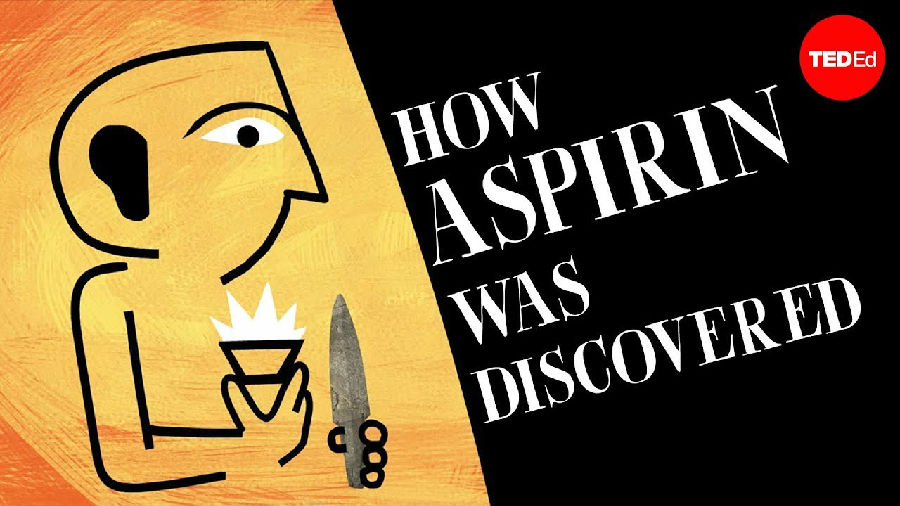(单词翻译:单击)
4,000 years ago, the ancient Sumerians made a surprising discovery.
4000年前,古苏美尔人发现了一个惊人的秘密。
If they scraped the bark off a particular kind of tree and ate it, their pain disappeared.
如果他们刮下一种特殊的树上的树皮,并吃下它,他们的疼痛就会消失。
Little did they know that why they'd found was destined to influence the future course of medicine.
他们当时并不知道,他们的这个发现会影响未来的医学方向。
What the Sumerians had discovered was a precursor to the medicine known today as aspirin.
苏美尔人在那时发现的药物,就是当今广为人知的阿司匹林的前身。
Aspirin's active ingredient is found commonly in willow trees and other wild plants,
阿司匹林的活性成分通常出现在柳树上,或者其他野生植物上,
which is how it came to infuse the medical traditions of Sumer, ancient Egypt, ancient Greece, and other cultures.
因此它被苏美尔人的医学历史所记载,也包括古埃及、古希腊和其他文化中。
Around 400 BC, Hippocrates, thought of as the father of modern medicine,
公元前四百年左右,现代医学之父希波克拉底,
first recommended chewing willow bark for pain relief and making willow leaf tea to ease the pain of childbirth.
第一个提出了咀嚼柳树皮可缓解疼痛,并制作柳叶茶以缓解分娩的痛苦。
But it took over 2,000 years for us to comprehensively investigate its potential.
但是我们花了两千多年的时间研究它的药效。
In the mid-18th century, an Englishman named Edward Stone ran five years of experiments,
在18世纪中期,一个名叫爱德华·斯通的英国人,经过五年的实验,
showing that willow bark crushed into a powder and eaten could cure a fever.
结果表明,食用压成粉末状的柳树皮,可以治愈发烧。
It took nearly another 70 years for a German pharmacist, Johann Buchner,
又花了将近70年,德国药剂师约翰·毕希纳,
to finally identify and purify the substance that made all this possible, a compound called salicin.
最终确定了这种有药效的物质,是一种叫水杨苷的化合物。
By then, doctors were routinely using willow bark and other salicin-rich plants,
那时候,医生可以使用柳树皮和其他富含水杨苷的植物,
like the herb meadowsweet, to ease pain, fever, and inflammation.
像草药或绣线菊属植物,来缓解疼痛,发烧和炎症。
But identifying the exact compound suddenly opened up the possibility of manipulating its form.
但确定了这种化合物打开了人们可以改变其形式的大门。
In 1853, a French chemist managed to chemically synthesize the compound, creating a substance called acetylsalicylic acid.
1853年,法国化学家开始研究这个合成化合物,创造了一种物质,乙酰水杨酸。
Then in 1897, the pharmaceutical company Bayer found a new method
然后在1897年,制药公司拜耳发现了一种新方法,
and began marketing the compound as a pain reliever called aspirin.
并开始营销这个化合物,这种止痛药被称为阿司匹林。
This was widely recognized as one of the first synthetic pharmaceutical drugs.
这是被广泛认可的第一种合成药物。
Originally, aspirin was just Bayer's brand name:
起初,阿司匹林只是拜耳公司的品牌名称:
A for acetyl, and spir for meadowsweet, whose botanical name is Spiraea ulmaria.
A是指乙酰基,spir指绣线菊属植物,其植物学名称是绣线菊属。
Soon, aspirin became synonymous with acetylsalicylic acid.
阿司匹林很快就成了乙酰水杨酸的代名称。

As its influence grew, aspirin was found to ease not just pain,
随着其发展,人们发现阿司匹林不仅可以缓解痛苦,
but also many inflammation-related problems,
还可以治愈许多炎症,
like rheumatoid arthritis, pericarditis, which enflames the fluid-filled sack around the heart,
例如,风湿关节炎、心包炎(心脏周围产生的炎症)、
and Kawasaki disease, where blood vessels become inflamed.
川崎病(血管病变产生的炎症)。
Yet, despite aspirin's medical value, at this point, scientists still didn't actually know how it worked.
然而,尽管阿司匹林具有医学价值,但在这时,科学家们还没有依据来证明它是如何治愈这些炎症的。
In the 1960s and 70s, Swedish and British scientists changed that.
20世纪60年代和70年代,瑞典和英国科学家改变了这一观点。
They showed that the drug interrupts the production of certain chemicals called prostaglandins,
他们通过中断药物,发现了这种化学物质,前列腺素,
which control the transmission of pain sensations and inflammation.
它可以控制疼痛感和炎症。
In 1982, that discovery won the researchers a Nobel Prize in Medicine.
1982年,这一物质的发现者获得了诺贝尔医学奖。
Over time, research has also uncovered aspirin's risks.
随着时间的推移,研究也发现了阿司匹林的风险。
Overconsumption can cause bleeding in the intestines and the brain.
过度服用会导致肠出血和脑出血。
It can also trigger Reye's Syndrome,
它也可以导致雷尔氏综合症,
a rare but often fatal illness that affects the brain and liver in children with an infection.
这一种罕见而又致命的疾病,它影响着大脑和肝脏,尤其是在儿童群体中更容易受到感染。
And in the late 20th century,
在二十世纪末期,
aspirin's success had been overshadowed by newer pain killers with fewer side effects, like acetaminophen and ibuprofen.
阿司匹林由新的止痛药所代替,这种新的药物副作用较少,例如,乙酰氨基酚和布洛芬。
But in the 1980s, further discoveries about aspirin's benefits revived interest in it.
但在20世纪80年代,阿司匹林又有了新的进展,它再次复兴。
In fact, the 1982 Nobel Prize winners also demonstrated that aspirin slows production of thromboxanes,
事实上,1982年诺贝尔奖得主也展示了阿司匹林可以减缓血栓素,
chemicals that cause clumping of platelets, which in turn form blood clots.
这种化学物质会使血小板结块,从而形成血栓。
A landmark clinical trial showed that aspirin reduced heart attack risk by 44% in participants who took the drug.
一个重大的临床试验表明,如果患者服用此药物的话,阿司匹林可以使心脏病发作风险降低44%。
Today, we prescribe it to people at risk of heart attack or stroke
今天,我们把用它来帮助患者降低心脏病发作或中风的危险,
because it cuts the likelihood of clots forming in the arteries that supply the heart and brain.
因为它可以减少供应心脏和大脑的动脉中凝块的产生。
Even more intriguingly, there's a growing body of research that suggests
更有趣的是,越来越多的研究表明,
aspirin reduces the risk of getting and dying from cancer, especially colorectal cancer.
阿斯匹林可以降低死于癌症的风险,尤其是结肠直肠癌。
This might be due to aspirin's anti-platelet effects.
这可能是由于阿司匹林抗血小板效应。
By reducing platelet activity, aspirin may decrease the levels of a certain protein that helps cancer cells spread.
通过减少血小板活性,阿司匹林可能会降低某种蛋白质的含量,抑制癌细胞的传播。
These discoveries have transformed aspirin from a mere pain reliever to a potentially life-saving treatment.
这些发现已经改变了阿司匹林,从一个简单的止痛药到一种挽救生命的药物。
Today, we consume about 100 billion aspirin tablets each year, and researchers continue searching for new applications.
今天,我们每年会消耗约1000亿片阿司匹林,研究人员也在继续探索其新的作用。
Already, aspirin's versatility has transformed modern medicine,
阿司匹林的药效已经改变了现代医学,
which is astounding considering its humble beginnings in a scraping of willow bark.
而让人们震惊的是这种药物的产生,竟然起源于刮树皮。


